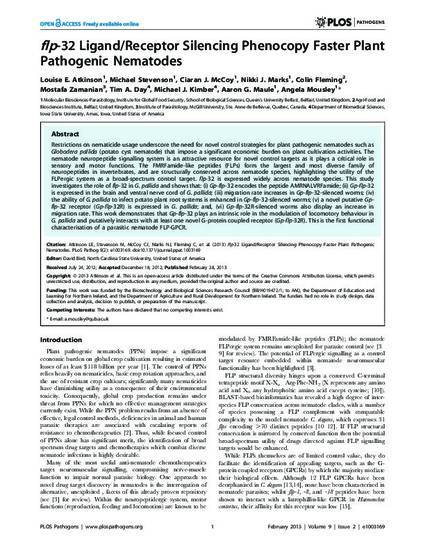
Restrictions on nematicide usage underscore the need for novel control strategies for plant pathogenic nematodes such as Globodera pallida (potato cyst nematode) that impose a significant economic burden on plant cultivation activities. The nematode neuropeptide signalling system is an attractive resource for novel control targets as it plays a critical role in sensory and motor functions. The FMRFamide-like peptides (FLPs) form the largest and most diverse family of neuropeptides in invertebrates, and are structurally conserved across nematode species, highlighting the utility of the FLPergic system as a broad-spectrum control target. flp-32 is expressed widely across nematode species. This study investigates the role offlp-32 in G. pallida and shows that: (i) Gp-flp-32 encodes the peptide AMRNALVRFamide; (ii)Gp-flp-32 is expressed in the brain and ventral nerve cord of G. pallida; (iii) migration rate increases in Gp-flp-32-silenced worms; (iv) the ability of G. pallida to infect potato plant root systems is enhanced in Gp-flp-32-silenced worms; (v) a novel putative Gp-flp-32 receptor (Gp-flp-32R) is expressed in G. pallida; and, (vi) Gp-flp-32R-silenced worms also display an increase in migration rate. This work demonstrates that Gp-flp-32 plays an intrinsic role in the modulation of locomotory behaviour in G. pallida and putatively interacts with at least one novel G-protein coupled receptor (Gp-flp-32R). This is the first functional characterisation of a parasitic nematode FLP-GPCR.
Available at: http://works.bepress.com/michael-kimber/9/

This article is from PLoS Pathog 9(2): e1003169. doi:10.1371/journal.ppat.1003169. Posted with permission.